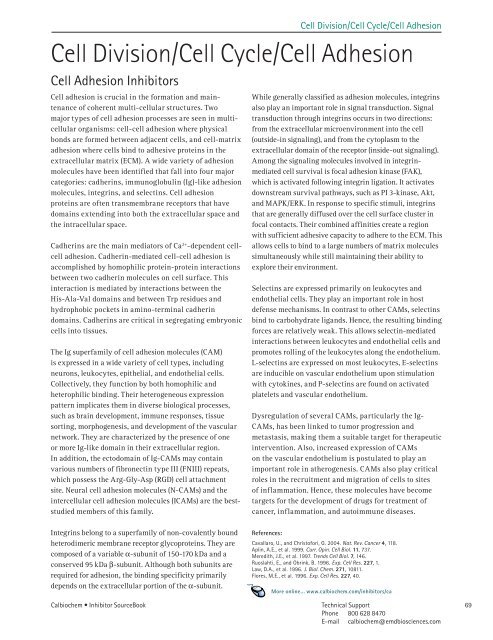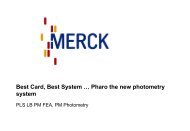Inhibitor SourceBook™ Second Edition
Inhibitor SourceBook™ Second Edition
Inhibitor SourceBook™ Second Edition
You also want an ePaper? Increase the reach of your titles
YUMPU automatically turns print PDFs into web optimized ePapers that Google loves.
Calbiochem • <strong>Inhibitor</strong> SourceBook<br />
Cell Division/Cell Cycle/Cell Adhesion<br />
Cell Division/Cell Cycle/Cell Adhesion<br />
Cell Adhesion <strong>Inhibitor</strong>s<br />
Cell adhesion is crucial in the formation and maintenance<br />
of coherent multi-cellular structures. Two<br />
major types of cell adhesion processes are seen in multicellular<br />
organisms: cell-cell adhesion where physical<br />
bonds are formed between adjacent cells, and cell-matrix<br />
adhesion where cells bind to adhesive proteins in the<br />
extracellular matrix (ECM). A wide variety of adhesion<br />
molecules have been identified that fall into four major<br />
categories: cadherins, immunoglobulin (Ig)-like adhesion<br />
molecules, integrins, and selectins. Cell adhesion<br />
proteins are often transmembrane receptors that have<br />
domains extending into both the extracellular space and<br />
the intracellular space.<br />
Cadherins are the main mediators of Ca 2+ -dependent cellcell<br />
adhesion. Cadherin-mediated cell-cell adhesion is<br />
accomplished by homophilic protein-protein interactions<br />
between two cadherin molecules on cell surface. This<br />
interaction is mediated by interactions between the<br />
His-Ala-Val domains and between Trp residues and<br />
hydrophobic pockets in amino-terminal cadherin<br />
domains. Cadherins are critical in segregating embryonic<br />
cells into tissues.<br />
The Ig superfamily of cell adhesion molecules (CAM)<br />
is expressed in a wide variety of cell types, including<br />
neurons, leukocytes, epithelial, and endothelial cells.<br />
Collectively, they function by both homophilic and<br />
heterophilic binding. Their heterogeneous expression<br />
pattern implicates them in diverse biological processes,<br />
such as brain development, immune responses, tissue<br />
sorting, morphogenesis, and development of the vascular<br />
network. They are characterized by the presence of one<br />
or more Ig-like domain in their extracellular region.<br />
In addition, the ectodomain of Ig-CAMs may contain<br />
various numbers of fibronectin type III (FNIII) repeats,<br />
which possess the Arg-Gly-Asp (RGD) cell attachment<br />
site. Neural cell adhesion molecules (N-CAMs) and the<br />
intercellular cell adhesion molecules (ICAMs) are the beststudied<br />
members of this family.<br />
Integrins belong to a superfamily of non-covalently bound<br />
heterodimeric membrane receptor glycoproteins. They are<br />
composed of a variable a-subunit of 150-170 kDa and a<br />
conserved 95 kDa b-subunit. Although both subunits are<br />
required for adhesion, the binding specificity primarily<br />
depends on the extracellular portion of the a-subunit.<br />
While generally classified as adhesion molecules, integrins<br />
also play an important role in signal transduction. Signal<br />
transduction through integrins occurs in two directions:<br />
from the extracellular microenvironment into the cell<br />
(outside-in signaling), and from the cytoplasm to the<br />
extracellular domain of the receptor (inside-out signaling).<br />
Among the signaling molecules involved in integrinmediated<br />
cell survival is focal adhesion kinase (FAK),<br />
which is activated following integrin ligation. It activates<br />
downstream survival pathways, such as PI 3-kinase, Akt,<br />
and MAPK/ERK. In response to specific stimuli, integrins<br />
that are generally diffused over the cell surface cluster in<br />
focal contacts. Their combined affinities create a region<br />
with sufficient adhesive capacity to adhere to the ECM. This<br />
allows cells to bind to a large numbers of matrix molecules<br />
simultaneously while still maintaining their ability to<br />
explore their environment.<br />
Selectins are expressed primarily on leukocytes and<br />
endothelial cells. They play an important role in host<br />
defense mechanisms. In contrast to other CAMs, selectins<br />
bind to carbohydrate ligands. Hence, the resulting binding<br />
forces are relatively weak. This allows selectin-mediated<br />
interactions between leukocytes and endothelial cells and<br />
promotes rolling of the leukocytes along the endothelium.<br />
L-selectins are expressed on most leukocytes, E-selectins<br />
are inducible on vascular endothelium upon stimulation<br />
with cytokines, and P-selectins are found on activated<br />
platelets and vascular endothelium.<br />
Dysregulation of several CAMs, particularly the Ig-<br />
CAMs, has been linked to tumor progression and<br />
metastasis, making them a suitable target for therapeutic<br />
intervention. Also, increased expression of CAMs<br />
on the vascular endothelium is postulated to play an<br />
important role in atherogenesis. CAMs also play critical<br />
roles in the recruitment and migration of cells to sites<br />
of inflammation. Hence, these molecules have become<br />
targets for the development of drugs for treatment of<br />
cancer, inflammation, and autoimmune diseases.<br />
References:<br />
Cavallaro, U., and Christofori, G. 2004. Nat. Rev. Cancer 4, 8.<br />
Aplin, A.E., et al. 999. Curr. Opin. Cell Biol. 11, 737.<br />
Meredith, J.E., et al. 997. Trends Cell Biol. 7, 46.<br />
Ruoslahti, E., and Obrink, B. 996. Exp. Cell Res. 227, .<br />
Law, D.A., et al. 996. J. Biol. Chem. 271, 08 .<br />
Flores, M.E., et al. 996. Exp. Cell Res. 227, 40.<br />
More online... www.calbiochem.com/inhibitors/ca<br />
Technical Support<br />
Phone 800 628 8470<br />
E-mail calbiochem@emdbiosciences.com<br />
69



